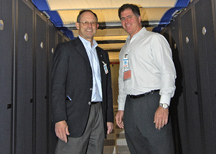
Michael Dell, chairman of Dell Corporation who in 1992 became the youngest CEO of any company listed on the Fortune 500, visited Sandia last Friday to tour Sandia’s Dell Thunderbird supercomputer and sign a commemorative plaque with Laboratories Director and President Tom Hunter.
Crowning the success of Dell’s entry with Sandia into the supercomputer market, the Sandia Dell Thunderbird is currently the sixth fastest supercomputer in the world on the widely accepted Linpac test. At its $15.2 million price tag, it is the cheapest per flop of any general-purpose supercomputer of its scale anywhere.
The signing took place in the Visualization facility at JCEL (the Joint Computational Engineering Lab). Tom and Dell spoke briefly on what supercomputing will mean to US industrial competitiveness and national security in terms of transforming engineering and science.
“This has been a truly remarkable partnership. I look at success in many ways, but this one has been outstanding. Leaders look at today’s norms and say, ‘tomorrow must be different.’ This project shows that we are doing that with Michael Dell, who has helped shape the way the world is thinking about information technology,” Tom said.
Sometimes referred to as the “Henry Ford of computers” for his success in bringing a technological product to market, Dell said, “All the great problems in physics, chemistry, and biology are really computational problems. We now have a great amount of computational power deployed at lessening institutional cost. We’ve done this in partnership with Sandia, using industry-standard technology. It’s fascinating to me to see our product used at Sandia in the great work you’re doing.”
A video produced by Sandia’s Regina Valenzuela (6039-1) showed the Thunderbird cluster in action. The highly original piece opened by showing a caterpillar turn into a butterfly, and then switched images to say that “the transformation from slide rule to supercomputer is as mysterious as any transformation in nature.”
Preceding the pageantry of the signing, which took place late in the day, was an early morning signing of an agreement that detailed future cooperation between the Labs and the computer company.
The agreement was signed by Sandia Div. 1000 VP Rick Stulen and Dell VP Jennifer Smith.
“The extraordinary results we have obtained to date on the Dell Thunderbird cluster are representative of the future of simulation-enabled engineering. Our agreement with Dell will enable our partnership to continue to focus on the future of high-performance computing,” Rick said.
One reason for the success of the 8,960-processor Thunderbird cluster — designed jointly by Sandia and Dell — is that Sandia and Dell were willing to gamble on a new “interconnect” technology that communicates between computer nodes. The interconnect, called Infiniband, had never before been deployed in a computing system of this scale or complexity. The ready availability of this now-proven component as an “off-the-shelf” commercial product may lead to an increase in the number of supercomputers worldwide by improving speed while lowering prices.